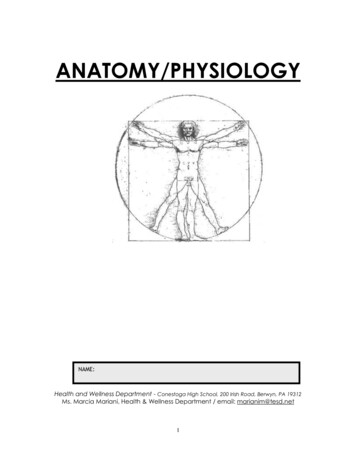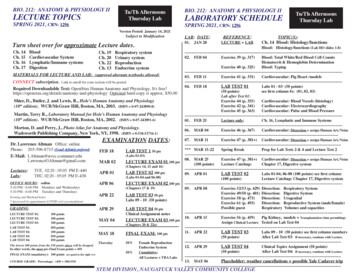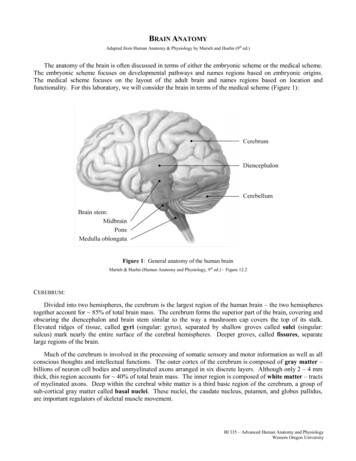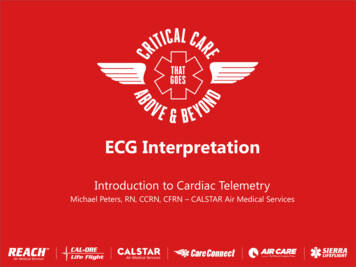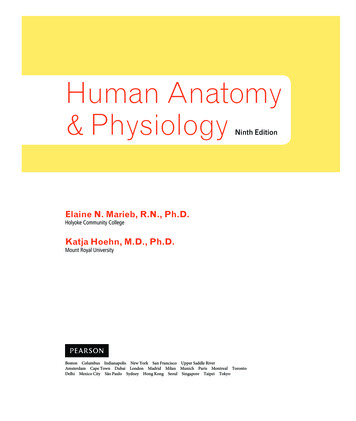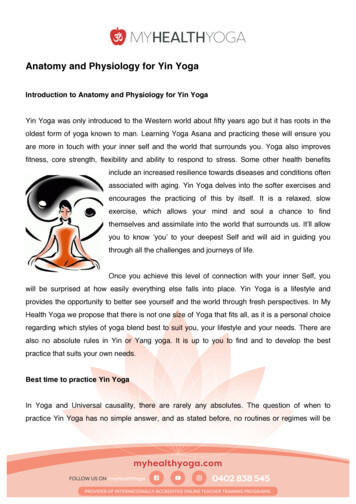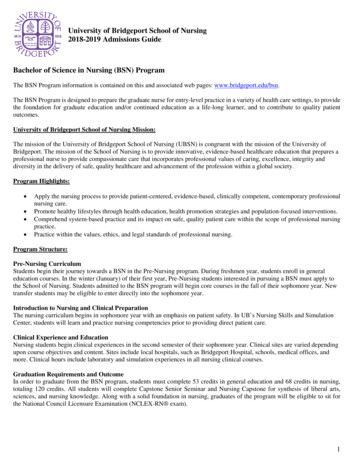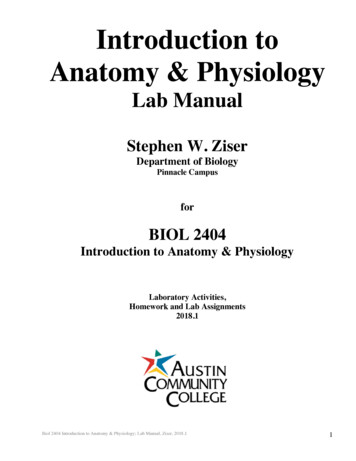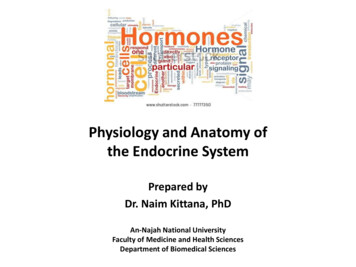
Transcription
Physiology and Anatomy ofthe Endocrine SystemPrepared byDr. Naim Kittana, PhDAn-Najah National UniversityFaculty of Medicine and Health SciencesDepartment of Biomedical Sciences
Introduction The nervous and endocrine systems are the major controllingsystems of the body. The nervous system exerts rapid controls via nerve impulses;the endocrine system exerts more prolonged effects viahormones.Dr. Naim Kittana, PhD2
The Endocrine System: An OverviewHormonally regulated processes include: Reproduction Growth and development Maintaining electrolyte, water, and nutrient balance Regulating cellular metabolism and energy balance Mobilizing body defenses.Dr. Naim Kittana, PhD3
Endocrine organsThey are ductless, well- vascularized glands that releasehormones directly into the blood or lymph.Dr. Naim Kittana, PhD4
The endocrine organs include PituitaryThyroidParathyroidAdrenalPineal glandsThe hypothalamus(a neuroendocrine organ) The pancreas Gonads PlacentaDr. Naim Kittana, PhD5
Notes Local chemical messengers, not generally considered part ofthe endocrine system, include autocrines, which act on thecells that secrete them, and paracrines, which act on adifferent cell type nearby. Most hormones are steroids or amino acid basedDr. Naim Kittana, PhD6
Mechanisms of Hormone Action Hormones alter cell activity by stimulating or inhibitingcharacteristic cellular processes of their target cells. Cell responses to hormone stimulation may involve: Changes in membrane permeability Enzyme synthesis, activation, or inhibition Secretory activity MitosisDr. Naim Kittana, PhD7
Plasma Membrane Receptorsand Second-Messenger SystemsDr. Naim Kittana, PhD8
Intracellular Receptors Steroid hormones (andthyroid hormone) entertheir target cells and effectresponses by activatingDNA, which initiatesmessenger RNA formationleading to protein synthesis.9
Target Cell Specificity The ability of a target cell to respond to a hormone dependson the presence of receptors, on its plasma membrane orwithin the cell, to which the hormone can bind. Hormone receptors are dynamic structures. High or low levelsof stimulating hormones can change the number and/orsensitivity of hormone receptors.Dr. Naim Kittana, PhD10
Control of Hormone Release Humoral, neural, or hormonal stimuli activate endocrineorgans to release their hormones. Negative feedback is important in regulating hormone levelsin the blood. The nervous system, acting through hypothalamic controls,can in certain cases override or modulate hormonal effectsDr. Naim Kittana, PhD11
Types of endocrine gland stimuli12
Half-Life, Onset, and Duration of Hormone Activity Blood levels of hormones reflect a balance between secretionand degradation/excretion. The liver and kidneys are the major organs that degradehormones; Breakdown products are excreted in urine and feces. Hormone half-life and duration of activity are limited and varyfrom hormone to hormone.Dr. Naim Kittana, PhD13
The Pituitary Gland andHypothalamusDr. Naim Kittana, PhD14
Pituitary-Hypothalamic Relationships The pituitary gland hangs from the base of the brain and isenclosed by bone. It consists of a hormone-producing glandular portion (anteriorpituitary or adenohypophysis) and a neural portion (posteriorpituitary or neurohypophysis), which is an extension of thehypothalamus. The neurohypophysis includes the infundibulum (stalk) andthe posterior pituitary.Dr. Naim Kittana, PhD15
16
The hypothalamus(a) synthesizes two hormones that it exports to the posteriorpituitary for storage and later release and(b) regulates the hormonal output of the anterior pituitary viareleasing and inhibiting hormones.Dr. Naim Kittana, PhD17
The Posterior Pituitary and Hypothalamic Hormones The posterior pituitary stores and releases two hypothalamichormones: Oxytocin Antidiuretic hormone (ADH)Dr. Naim Kittana, PhD18
Oxytocin It stimulates powerful uterine contractions, which triggerlabor and delivery of an infant It stimulates milk ejection in nursing women. Its release is mediated reflexively by the hypothalamus andrepresents a positive feedback mechanism.Dr. Naim Kittana, PhD19
Antidiuretic hormone (ADH) It stimulates the kidney tubules to reabsorb and conservewater, resulting in small volumes of highly concentrated urineand decreased plasma solute concentration. ADH is released in response to high solute concentrations inthe blood and inhibited by low solute concentrations in theblood. Hyposecretion results in diabetes insipidusDr. Naim Kittana, PhD20
Anterior Pituitary Hormones Four of the six anterior pituitary hormones are tropichormones that regulate the function of other endocrineorgans. Most anterior pituitary hormones exhibit a diurnal rhythm ofrelease, which is subject to modification by stimuli influencingthe hypothalamus.Dr. Naim Kittana, PhD21
Anterior Pituitary Hormones22
Anterior Pituitary Hormones Growth hormone (GH) Thyroid-stimulating hormone (TSH) Adrenocorticotropic hormone (ACTH) The gonadotropins—follicle-stimulating hormone (FSH) andluteinizing hormone (LH) Prolactin (PRL)Dr. Naim Kittana, PhD23
Growth hormone (GH) (somatotropin) It is an anabolic hormone that stimulates growth of all bodytissues but especially skeletal muscle and bone. It may act directly, or indirectly, via insulin-like growth factors(IGFs). GH mobilizes fats, stimulates protein synthesis, and inhibitsglucose uptake and metabolism. Its secretion is regulated by growth hormone–releasinghormone (GHRH) and growth hormone–inhibiting hormone(GHIH), or somatostatin.Dr. Naim Kittana, PhD24
Growth-promoting and metabolic actions of GH25Dr. Naim Kittana, PhD
Growth hormone (GH) Hypersecretion causesgigantism in childrenand acromegaly inadults Hyposecretion inchildren causespituitary dwarfism.Dr. Naim Kittana, PhD26
Thyroid-stimulating hormone (TSH) TSH promotes normaldevelopment and activity ofthe thyroid gland. Thyrotropin releasing hormone(TRH) stimulates release of TSH Negative feedback of thyroidhormone inhibits it. GHIH also inhibits TSHsecretionDr. Naim Kittana, PhD27
Anterior Pituitary Hormones28
Adrenocorticotropic hormone (ACTH) It stimulates the adrenal cortex to release corticosteroids. Corticotropin-releasing hormone (CRH) triggers ACTH release Rising glucocorticoid levels inhibit it.Dr. Naim Kittana, PhD29
Anterior Pituitary Hormones30
FSH and LH The gonadotropins—FSH and LH—regulate the functions ofthe gonads in both sexes. In both sexes, FSH stimulates production of gametes (spermor eggs), while LH stimulates gonadal hormone production.Dr. Naim Kittana, PhD31
FSH and LH In females, LH works with FSH to cause an egg-containingovarian follicle to mature. LH then triggers ovulation andpromotes synthesis and release of ovarian hormones. In males, LH stimulates the interstitial cells of the testes toproduce the male hormone testosterone. Gonadotropin levels rise in response to gonadotropinreleasing hormone (GnRH). Negative feedback of gonadal hormones inhibitsgonadotropin release.Dr. Naim Kittana, PhD32
Dr. Naim Kittana, PhD33
FSH and LH Gonadotropins are virtually absent from the blood ofprepubertal boys and girls. During puberty, the gonadotropic cells of the anteriorpituitary are activated and gonadotropin levels rise, causingthe gonads to mature. In both sexes, gonadotropin releasing hormone (GnRH)produced by the hypothalamus prompts gonadotropinrelease. Gonadal hormones, produced in response to thegonadotropins, feed back to suppress FSH and LH release.34
Prolactin (PRL) It promotes milk production in humans. Its secretion is inhibited by dopamine, that acts as a prolactininhibiting hormone (PIH) Hypersecretion of prolactin (hyperprolactinemia) causes: Females: inappropriate lactation, lack of menses andinfertility Males: ImpotenceDr. Naim Kittana, PhD35
The Thyroid Gland36
The Thyroid GlandDr. Naim Kittana, PhD37
The Thyroid Gland The thyroid gland is located in the anterior neck. Thyroid follicles store colloid containing thyroglobulin, aglycoprotein from which thyroid hormone is derived. Thyroid hormone (TH) includes thyroxine (T4) andtriiodothyronine (T3), which increase the rate of cellularmetabolism. Consequently, oxygen use and heat productionrise.38
Steps of thyroid hormone synthesis:1. Iodide is uptaken in response to TSH hormone2. Iodide is oxidized by thyroidal peroxidase to iodine3. Tyrosine on thyroglobulin is iodinated and forms MIT & DIT4. Iodotyrosines condensationMIT DIT T3; DIT DIT T4Dr. Naim Kittana, PhD39
The Thyroid Gland Secretion of thyroid hormone, prompted by TSH, requires thefollicular cells to take up the stored colloid and split thehormones from the colloid for release. Rising levels of thyroid hormone feed back to inhibit theanterior pituitary and hypothalamus. Most T4 is converted to T3 (the more active form) in thetarget tissues. These hormones act by turning on gene transcription andprotein synthesis.Dr. Naim Kittana, PhD40
Mechanism of actions of thyroid hormonesDr. Naim Kittana, PhDBMR: basal metabolic rate41
Homeostatic Imbalance of the Thyroid GlandHypothyroid disorders may result from: Thyroid gland defects Secondarily from inadequate TSH or TRH release. When the thyroid gland is removed surgically When dietary iodine is inadequate Hypothyroidism conditions: Myxedema, Goiter, Cretinism Hyperthyroidism condition: Graves’ diseaseDr. Naim Kittana, PhD42
Myxedema Full-blown hypothyroid syndrome In adults. Symptoms include: Low metabolic rate Feeling chilled Constipation Thick dry skin Puffy eyes Edema Lethargy Mental sluggishness (but not mental retardation)Dr. Naim Kittana, PhD43
Goiter An enlarged protruding thyroid gland Occurs if myxedema results from lack ofIodine The follicular cells produce colloid butcannot iodinate it and make functionalhormones. The pituitary gland secretes increasingamounts of TSH in an attempt tostimulate the thyroid to produce TH, butthe only result is that the folliclesaccumulate more and more unusablecolloid.Dr. Naim Kittana, PhD44
Cretinism Severe hypothyroidism in infants The child is mentally retarded and has a short,disproportionately sized body and a thick tongue and neck Thyroid hormone replacement therapy can preventcretinism if diagnosed early enoughDr. Naim Kittana, PhD45
Graves’ disease The most common hyperthyroid disease It is an autoimmune condition, where abnormal antibodiesare directed against thyroid follicular cells. Rather than marking these cells for destruction asantibodies normally do, these antibodies mimic TSH andcontinuously stimulate TH release.Dr. Naim Kittana, PhD46
Typical symptoms of Graves’ disease Elevated metabolic rateSweatingRapid and irregular heartbeatNervousnessWeight loss despite adequate foodEyeballs may protrude(exophthalmos) if the tissue behindthe eyes becomes edematous andfibrousDr. Naim Kittana, PhD47
Parafollicular (C) Cells of the Thyroid Gland They produce calcitonin It is not normally important in calcium homeostasis At pharmacological levels, it inhibits bone matrix resorptionand enhances calcium deposit in boneDr. Naim Kittana, PhD48
The Parathyroid Glands(a) The parathyroid glands are located on the posterior aspect of the thyroid gland and may be more49inconspicuous than depicted. (b) Photomicrograph of parathyroid gland tissue (1603).
The Parathyroid Glands They secrete parathyroid hormone(PTH), which increases bloodcalcium levels. It targets bone, the kidneys, and thesmall intestine (indirectly viavitamin D activation). PTH is the key hormone for calciumhomeostasis. Falling blood calcium levels triggerPTH release; rising blood calciumlevels inhibit its release.50
Imbalance of PTH Hyperparathyroidism results in hypercalcemia and extremebone wasting Hypoparathyroidism leads to hypocalcemia, evidenced bytetany, respiratory paralysis and deathDr. Naim Kittana, PhD51
The Adrenal (Suprarenal) GlandsDr. Naim Kittana, PhD52
The Adrenal (Suprarenal) Glands The paired adrenal (suprarenal) glands sit atop the kidneys. Each adrenal gland has two functional portions,a) The cortex andb) The medullaDr. Naim Kittana, PhD53
The Adrenal (Suprarenal) GlandsDr. Naim Kittana, PhD54
Hormones of the Adrenal Cortex Mineralocorticoids: help control the balance of minerals andwater in the blood. Glucocorticoids: influence the energy metabolism of mostbody cells and help resist stressorsDr. Naim Kittana, PhD55
Major mechanismscontrollingaldosterone releasefrom the adrenalcortexDr. Naim Kittana, PhD56
Homeostatic Imbalance of Aldosterone Aldosteronism: hypersecretion of aldosterone Cause: adrenal tumors. Two major sets of problems result:(1) Hypertension and edema due to excessive Na2 and waterretention(2) K depletion: as a result, neurons become nonresponsive,leading to muscle weakness and eventually paralysisDr. Naim Kittana, PhD57
Glucocorticoids They include cortisol (hydrocortisone, the main hormone),cortisone, and corticosterone Under normal circumstances: Help the body adapt to intermittent food intake by keepingblood glucose levels fairly constant Maintain blood pressure by increasing the action ofvasoconstrictors. Under severe stress due to hemorrhage, infection, or physicalor emotional trauma evokes a dramatically higher output ofGlucocorticoids,Dr. Naim Kittana, PhD58
Stress and the adrenal gland59
Normal regulation of glucocorticoid levels Cortisol secretory bursts, driven by patterns of eating andactivity, occur in a definite pattern throughout the day andnight. Cortisol blood levels peak shortly before we rise in themorning. The lowest levels occur in the evening just before and shortlyafter we fall asleep. However, acute stress of any variety interrupts the normalcortisol rhythmDr. Naim Kittana, PhD60
Physiological Effects of Glucocorticoids Cortisol rises blood levels of glucose, fatty acids, and aminoacids. Cortisol’s prime metabolic effect is to provoke gluconeogenesis,(formation of glucose from fats and proteins) In order to “save” glucose for the brain, cortisol mobilizes fattyacids from adipose tissue and encourages their increased usefor energy.Dr. Naim Kittana, PhD61
Physiological Effects of Glucocorticoids Cortisol induces the breakdown of stored proteins to providebuilding blocks for repair or to make enzymes for metabolicprocesses. Cortisol enhances the sympathetic nervous system’svasoconstrictive effects, and the rise in blood pressure to helpensure that these nutrients are quickly distributed to cells.Dr. Naim Kittana, PhD62
Physiological Effects of Glucocorticoids Ideal amounts of glucocorticoids promote normal functions, buttoo much cortisol exerts significant anti-inflammatory and antiimmune effectsDr. Naim Kittana, PhD63
Glucocorticoids Homeostatic Imbalance(Cushing’s syndrome) Results from excess Glucocorticoids secretion Etiology: ACTH-releasing malignancy of the lungs, pancreas, orkidneys; or by a tumor of the adrenal cortex Drug-inducedDr. Naim Kittana, PhD64
Symptoms of Cushing’s syndrome: Swollen “moon” face Redistribution of fat to theabdomen and theposterior neck (causing a“buffalo hump”), Hyperglycemia and othermetabolic disturbancesincluding steroid-induceddiabetes mellitus andweight gainDr. Naim Kittana, PhD65
Symptoms of Cushing’s syndrome: Osteoporosis Peptic ulcer Cataracts and increased intraocular pressure leading toglaucoma Edema Hypertension Increased susceptibility to infection Easy bruising and poor wound healing Muscle weakness and tissue lossDr. Naim Kittana, PhD66
Glucocorticoids Homeostatic Imbalance(Addison’s disease) The major hyposecretory disorder of the adrenal cortex Involves deficits in both glucocorticoids andmineralocorticoids. Symptoms: Weight loss Drop in plasma glucose and sodium levels Hyperkalemia (high plasma potassium levels) Severe dehydration and hypotensionCorticosteroid replacement therapy is the usual treatment.Dr. Naim Kittana, PhD67
Gonadocorticoids (Adrenal Sex Hormones) Most gonadocorticoids secreted by the adrenal cortex areweak androgens, or male sex hormones Most are converted in tissue cells to more potent malehormones, such as testosterone, and some are converted toestrogens. The secreted amounts are relatively littleDr. Naim Kittana, PhD68
The Adrenal Medulla Part of the autonomic nervous system Made up of medullary chromaffin cells They synthesize the catecholamines epinephrine andnorepinephrine (NE) from tyrosine amino acid Approximately 80% is epinephrine and 20% norepinephrine Activated by the sympathetic nervous system in response tostressDr. Naim Kittana, PhD69
Physiological effects of sympathetic nervous system Blood vessels constrict and the heart beats faster (togetherraising the blood pressure) Blood is diverted from temporarily nonessential organs to theheart and skeletal muscles. Blood glucose levels riseDr. Naim Kittana, PhD70
Homeostatic Imbalance of Catecholamines(Pheochromocytoma) Medullary chromaffin cell tumor that hypersecretcatecholamines Produces symptoms of uncontrolled sympathetic nervoussystem activity: Hyperglycemia (elevated blood glucose), Increased metabolic rate Rapid heartbeat and palpitations Hypertension Intense nervousness, and sweatingDr. Naim Kittana, PhD71
The Pineal GlandDr. Naim Kittana, PhD72
The Pineal Gland Tiny, pine cone–shaped pineal gland hangs from the roof ofthe third ventricle in the diencephalon Mainly secrets Melatonin hormone Melatonin concentrations in the blood rise and fall in a diurnal(daily) cycle: Peak levels occur during the night and make usdrowsy, and lowest levels occur around noon. The pineal gland indirectly receives input from the visualpathways concerning the intensity and duration of daylightDr. Naim Kittana, PhD73
The Pancreas Located partially behind the stomach in the abdomen is a mixed gland composed of both endocrine and exocrinegland cells Acinar cells, forming the bulk of the gland, produce anenzyme-rich juice that is carried by ducts to the smallintestine during digestion Scattered among the acinar cells are approximately a millionpancreatic islets (islets of Langerhans) tiny cell clusters thatproduce pancreatic hormonesDr. Naim Kittana, PhD74
Islets of Langerhans Contain two major populations of hormone-producing cells: Alpha (a) cells: synthesize glucagon (hyperglycemichormone) Beta (β) cells: Synthesize insulin (hypoglycemic hormone)Dr. Naim Kittana, PhD75
Glucagon The major target of glucagon is the liver, where it promotesthe rise of blood glucose levels by: Breakdown of glycogen to glucose (glycogenolysis) Synthesis of glucose (gluconeogenesis) Release of glucose to the blood by liver cells Glucagon release is suppressed by rising blood glucose levelsand by insulinDr. Naim Kittana, PhD76
Insulin Synthesized as part of a larger polypeptide chain calledproinsulin. Enzymes then excise the middle portion of this chain,releasing functional insulin Main effect is to lower blood glucose levels but it alsoinfluences protein and fat metabolismDr. Naim Kittana, PhD77
Circulating insulin lowers blood glucose levels in threeways: Enhances membrane transport of glucose (and other simplesugars) into most body cells, especially muscle and fat cells. Inhibits the breakdown of glycogen to glucose. Inhibits the conversion of amino acids or fats to glucose.Insulin is NOT needed for glucose entry into liver, kidney, andbrain tissueDr. Naim Kittana, PhD78
Insulin and glucagonfrom the pancreasregulate blood glucoselevels79
Factors That Influence Insulin Release Elevated blood glucose levels Rising blood levels of amino acids and fatty acids Release of acetylcholineDr. Naim Kittana, PhD80
Homeostatic Imbalance: Diabetes mellitus (DM) Types: Type 1 DM: When insulin is absent Type 2 DM: If insulin is present, but its effects are deficient In either case, blood glucose levels remain high after a mealbecause glucose is unable to enter most tissue cells.Dr. Naim Kittana, PhD81
Signs of DM: Polyuria: Excessive glucose in the blood leads to excessiveglucose in the kidney filtrate where it acts as an osmoticdiuretic Polydipsia: in response to dehydration Polyphagia (excessive hunger)Dr. Naim Kittana, PhD82
When hyperglycemia becomes excessive, the person begins tofeel nauseated This precipitates the fight-or-flight response. This response results, in all the reactions that normally occurin the hypoglycemic (fasting) state to make glucose available: Glycogenolysis Lipolysis (breakdown of fat) and gluconeogenesisDr. Naim Kittana, PhD83
When sugars cannot be used as cellular fuel, more fats aremobilized, resulting in high fatty acid levels in the blood, acondition called lipidemia In severe cases of DM, blood levels of fatty acids and theirmetabolites (acetoacetic acid, acetone, and others) risedramatically (Ketoacidosis)Dr. Naim Kittana, PhD84
Consequences of Untreated ketoacidosis It disrupts heart activity and oxygen transport Causes severe depression of the nervous system leads to coma and deathDr. Naim Kittana, PhD85
The GonadsDr. Naim Kittana, PhD86
Ovaries Oval organs located in the female’s abdominopelvic cavity. Besides producing ova, or eggs, the ovaries produce severalhormones, most importantly estrogens and progesteroneDr. Naim Kittana, PhD87
Physiological functions of the ovaries Alone, the estrogens are responsible for: Maturation of the reproductive organs The appearance of the secondary sex characteristics offemales at puberty. Acting with progesterone it promotes : Breast development and Cyclic changes in the uterine mucosaDr. Naim Kittana, PhD88
Male testes Located in an extra-abdominal skin pouch called the scrotum They produce sperm and male sex hormones, primarilytestosteroneDr. Naim Kittana, PhD89
Physiological functions testosterone: Maturation of the male reproductive organsThe appearance of secondary sex characteristics and sex driveNecessary for normal sperm productionMaintenance of the reproductive organs in their maturefunctional state in adult malesDr. Naim Kittana, PhD90
91
92
93
94
Introduction The nervous and endocrine systems are the major controlling systems of the body. The

